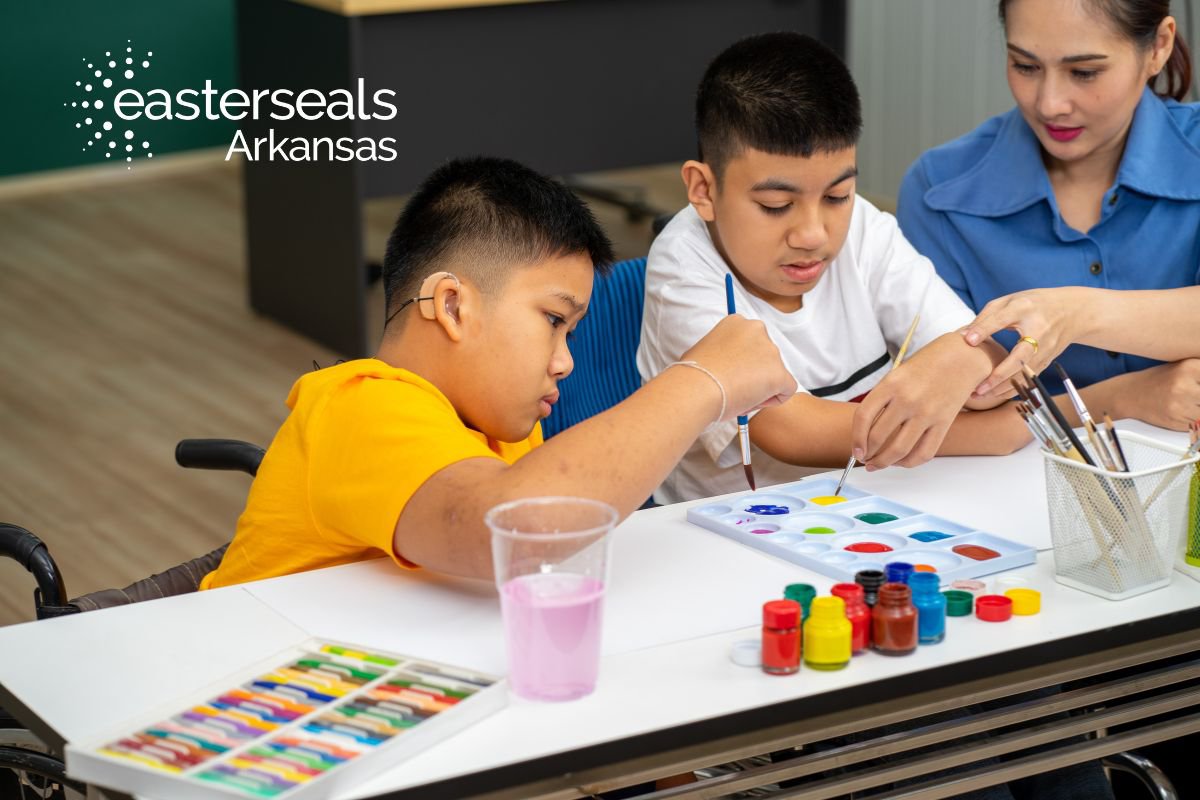
If your child has autism, you know school can be difficult without the right support. Indeed, many classrooms overlook sensory needs, predictable routines, or different learning styles. However, the right tools can change that. Therefore, we’ll go over which autism classroom accommodations are most helpful—and why. Let’s build better school days together.
Key Takeaways:
- Firstly, sensory accommodations include quiet zones, sensory tools (e.g., fidgets, noise-canceling headphones), and breaks.
- Moreover, visual schedules, first–then boards, and cues reduce anxiety and aid transitions.
- Additionally, flexible seating like wiggle stools, yoga balls, and HowdaHug chairs support focus.
- Furthermore, soft lighting, sound control, and clutter-free spaces limit sensory overload.
- Calm-down areas, consequently, give students a space to regulate emotions with comforting tools and seating.
- Importantly, IEPs/504 Plans list accommodations and are created by a school team with family input.
- In addition, visual checklists, timers, and step-by-step tasks help build independence and executive function.
- BIPs are based on behavior assessments and, as a result, focus on teaching positive actions.
- Social skills grow through peer buddies, direct teaching, and structured group activities, thereby fostering interaction.
- Additionally, tech tools support communication and organization, but should be balanced with physical materials and tasks.
- Differentiated instruction and adjusted assignments meet varied learning needs, ensuring all students are accommodated.
- Finally, predictable routines, visuals, and clear rules reduce anxiety and promote consistency.
- Working with families and support staff, ultimately, helps provide consistent, individualized accommodations.

Autism Classroom Accommodations: Practical Strategies That Support Every Learner
Creating an inclusive classroom means meeting students where they are, and for autistic learners, this includes thoughtfully planned accommodations that support comfort, focus, and growth. Therefore, these autism classroom accommodations aren’t just helpful—they’re essential. They not only foster understanding but also reduce anxiety, making learning accessible for every student.
Whether you're a teacher, caregiver, or school staff member, the following guide offers approachable strategies to support autistic students effectively. All ideas are grounded in real classroom experience and supported by trusted resources like Easterseals Arkansas.
Support Sensory Needs with Thoughtful Tools and Spaces
Autism classroom accommodations often begin with sensory support. Since autistic students may experience the classroom environment more intensely, sensory-friendly adjustments are key.
- Firstly, provide sensory tools such as fidget items, chew-safe jewelry, weighted lap pads, or noise-canceling headphones.
- Additionally, offer movement breaks through activities like stretching, yoga, or walking around the room.
- Moreover, create quiet corners by using soft lighting, bean bags, or HowdaHug chairs to calm overwhelmed students.
These tools should be personalized because what soothes one student may not help another. Therefore, give students options and let them choose what works.
Explore more sensory strategies in this calming guide.
Use Visual Schedules and Cues to Build Predictability
Visual supports, crucial for providing structure to the day, are invaluable to many autistic students. Indeed, they rely on these tools to effectively navigate transitions and reduce stress.
- Daily schedules: By using images or icons, you can clearly show what comes next.
- First–then boards: These help students understand task sequences, thereby easing transitions.
- Visual timers: Countdown clocks or sand timers prepare students for upcoming activity changes, promoting a smoother flow.
These supports boost independence. When routines are clear and visible, students trust the process and participate more openly.
Choose Flexible Seating That Supports Comfort and Focus
Seating options should accommodate different sensory and physical needs. Indeed, a one-size-fits-all chair doesn’t work for everyone.
- Firstly, wiggle stools or yoga balls help students who need movement.
- Moreover, bean bags or HowdaHug chairs offer deep pressure support.
- Additionally, foot bands under desks support quiet leg movement.
Ultimately, allow students to try different options and identify what helps them feel calm and focused. Furthermore, a flexible layout, with quiet zones and learning spaces clearly defined, enhances focus and well-being.
Modify the Environment to Minimize Overload
A well-designed classroom lowers stress and improves focus because it considers the sensory needs of students. By incorporating elements like soft lighting and organized spaces, the environment becomes more calming. Consequently, students can concentrate better and feel more comfortable throughout their school day.
Use Soft Lighting and Reduce Noise
- First, avoid harsh fluorescent lights—use warm-toned LEDs or natural light instead.
- Next, add rugs or wall panels to absorb sound effectively.
- Finally, use tennis balls on chair legs to reduce scraping noises.
Keep Spaces Organized and Clutter-Free
- First, use labeled bins and closed storage to keep materials organized.
- Next, keep wall decorations simple and minimal to reduce distractions.
- Finally, clearly define learning zones (e.g., reading, art, rest) with signs for easy navigation.
By implementing these changes, autistic students can feel secure and ready to learn.
Explore environmental tips on Supporting Children with Disabilities.
Use IEPs and 504 Plans to Guide Individualized Supports
Autism classroom accommodations are often legally documented through an IEP or 504 Plan. These plans ensure consistent support across all school settings.
- IEPs, for instance, are designed for students needing specialized instruction.
- Meanwhile, 504 Plans provide accommodations without altering the curriculum.
Both require evaluation, family input, and regular updates.
Understand the Difference Between Accommodations and Modifications
- Accommodations: Change how students learn (e.g., extra time, audiobooks).
- Modifications: Change what students learn (e.g., simpler assignments).
Every support in the classroom must align with the student’s plan.
Support Executive Function with Tools for Organization and Time
Many autistic students face challenges with executive function, which includes managing time, staying organized, and completing tasks. Consequently, these difficulties can lead to increased anxiety and hinder their academic success. Therefore, providing structured support and practical tools can significantly enhance their ability to manage daily tasks more effectively.
Tools That Help:
- Firstly, visual checklists: These break down steps for tasks, providing clarity.
- Next, color-coded folders: They help organize subjects or assignments systematically.
- Finally, timers: These are useful for assisting with transitions and pacing effectively.
Task simplification—breaking down assignments into bite-sized goals—builds motivation and success. These tools also promote independence, giving students ownership over their learning.
Support Emotional Regulation with Calming Spaces and Plans
Create Calm-Down Areas
A quiet space can effectively prevent overwhelm from turning into meltdowns.
- To begin, use dim lighting, soft seating, and calming textures.
- Additionally, include sensory tools like sand timers or stress balls.
- Finally, allow brief, self-directed use when needed.
Develop Behavior Intervention Plans (BIPs)
A BIP is created after a Functional Behavior Assessment (FBA) and includes:
- Firstly, identify triggers and prevention strategies.
- Secondly, focus on replacement behaviors to teach.
- Additionally, incorporate positive reinforcement systems.
Ultimately, remember that punishment doesn’t teach; rather, encouragement does.
Promote Social Skills and Peer Interaction
Social development is a core need for many autistic students, helping them build essential communication skills and confidence. By fostering environments that promote interaction, educators can create supportive spaces where autistic learners thrive. Effective autism classroom accommodations, such as structured group activities and peer support, can significantly enhance social growth and inclusion.
Use Peer Buddies
Pair students with peers who model positive interaction. This builds confidence and inclusion for both students.
Teach Social Communication Directly
- Use social stories, visuals, and scripts.
- Role-play interactions.
- Praise effort, not just skill.
Structure Group Work Carefully
- Keep groups small and roles clear.
- Provide adult support as needed.
- Use visual instructions and quiet spaces.
These approaches build confidence in social settings and help autistic students feel like valued members of the class.
Enhance Learning with Assistive Technology
Autism classroom accommodations often include tech supports that boost communication and organization.
Helpful Tools Include:
- Speech-generating apps: Like Proloquo2Go.
- Text-to-speech software: Supports reading and writing.
- Visual schedule apps: Like Choiceworks.
- Calming apps: Offer breathing exercises or music.
Balance is key—technology should support, not replace, face-to-face learning and play.
Adapt Instruction to Fit Learning Styles
Autistic students learn in unique and powerful ways. Instruction should meet them where they are.
Use These Strategies:
- Direct, clear language: Avoid metaphors or sarcasm.
- Visual and tactile aids: Charts, objects, and hands-on materials.
- Strength-based planning: Use student interests to build lessons.
Try Differentiated Instruction
Offer multiple ways to access content:
- Read aloud
- Type responses
- Use visuals or spoken answers
This boosts engagement and reduces frustration.
Maintain Structure and Consistency Throughout the Day
Routine builds comfort and confidence.
Tools for Structure:
- Visual schedules
- First–then boards
- Clear, posted rules
- Countdown timers
Label classroom zones and give advance notice of changes. Predictability helps students feel calm and ready to learn.
Collaborate with Families and Specialists
No one supports a student better than the people who know them best.
Build a Strong Team:
- Include caregivers, teachers, therapists, and counselors.
- Share updates regularly through notes or quick meetings.
- Ask families what works at home and use it in class.
Open communication builds trust and ensures the student gets consistent support across every environment.
For more on building inclusive teams, explore Easterseals programs and services.
Connect With Us for Autism Classroom Accommodations Support
Whether you're a parent or educator, you don’t have to navigate this alone. Easterseals Arkansas offers personalized support, programs, and resources to help you meet each learner’s needs. Let’s build inclusive classrooms—together.
Reach out to Easterseals Arkansas today to learn how we can support your school, your students, and your goals.
